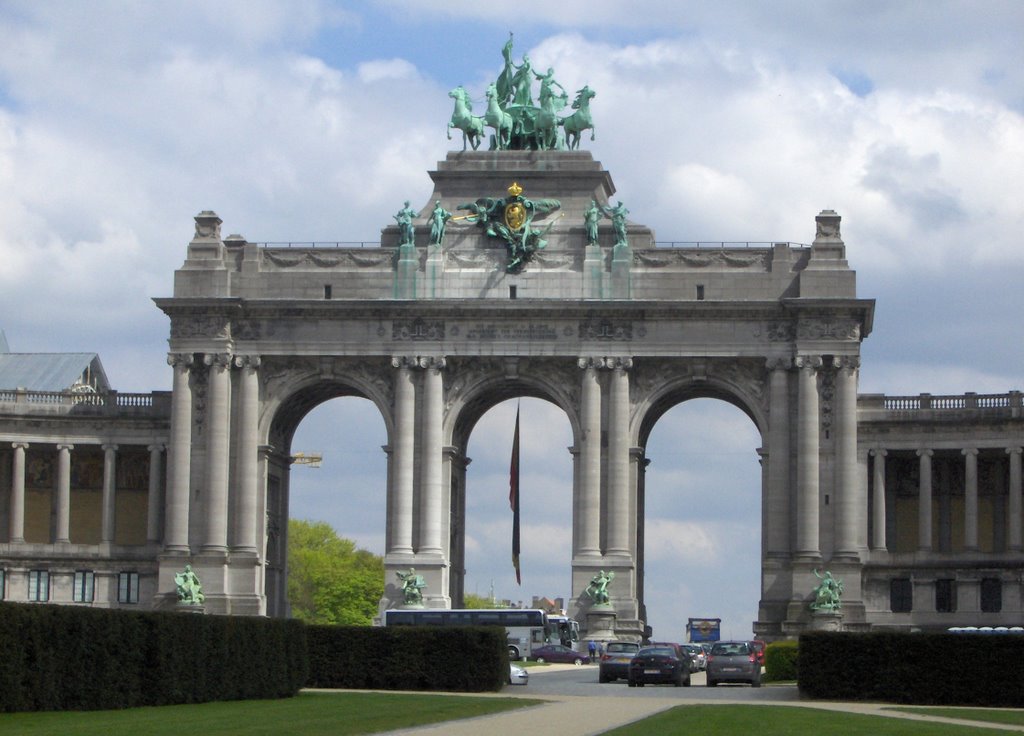Further from the centre:
- The Cinquantenaire Park – The controversial King Leopold II had the site around the Cinquantenaire Park built to celebrate the 50th anniversary of Belgium’s independence (1880). The park contains real treasures such as the great mosque, the statue of the green dog, the Temple of Human Passions, also known as Pavillon Horta-Lambeaux , … etc. The park comprises 30 hectares of classical gardens with beautiful rows of trees, symmetrically organised around a central axis.

The most striking structure in the park is the triumphal arch, which was completed in 1905. It consists of three equal arches with above the middle arch a bronze statue representing Brabant on a chariot pulled by four horses. At the foot of the triumphal arch, a total of eight statues representing the other provinces (formerly 9) can be found on both sides. The colonnade that starts on either side of the arch leads to buildings that house the following museums, among others:
- The Royal Museum of the Army and Military History – https://www.klm-mra.be/D7t/en – just behind it, the Royal Military School – http://www.rma.ac.be/en/
- Museum van het Leger en de Krijgsgeschiedenis
- Koninklijke Militaire School
- Autoworld, a private museum about car history – https://www.autoworld.be/home
- The Royal Museums of Art and History – http://www.kmkg-mrah.be/nl/koninklijke-musea-voor-kunst-en-geschiedenis
- The Autrique House – The Autrique House is a mansion in Schaerbeek (Brussels) and is one of the first buildings designed by art nouveau architect Victor Horta in Brussels. The house was completely restored in 2004. It is also a gem of the Art Nouveau style. – http://www.autrique.be/en/
- The Cauchie-house (https://www.brusselsmuseums.be/en/museums/cauchie-house ) The Cauchie-house, Paul Cauchie’s own house, built in 1905, can be considered one of the most beautiful art nouveau realisations in Brussels. Cauchi specialized in the design of sgraffiti. The term sgraffito is derived from the Italian word sgraffitto which means “scratched”. Sgraffito is the name of an old but obsolete decoration technique that flourished again at the end of the 19th century. The sgraffiti are part of our architectural heritage.
- The Hortahouse – The Hortamuseum is located in the home and studio of Victor Horta (American Street 25, Sint-Gillis, Brussels). Together with three other Horta Art Nouveau houses, it is on the UNESCO World Heritage List. A visit to this beautiful Art Nouveau house is definitely worthwhile. – http://www.hortamuseum.be/nl/info
Hortahuis
- The Solvay House – was built by Victor Horta for the rich industrial Armand Solvay. In this beautiful Art Nouveau house you can see, among other things, a glass entrance hall with floral motifs in carved wood, an imposing staircase and one of the most beautiful and famous murals of Theo Van Rysselberghe in pointillism. Unfortunately the house is only opened sporadically.
- The Atomium – The Atomium was designed by the engineer André Waterkeyn and built as part of the Brussels World Fair in 1958, the so-called Expo 58. It is a steel construction consisting of nine spheres, each with a diameter of 18 metres. The spheres made of aluminium form the cubically spatially centred crystal structure of iron, enlarged 165 billion times. Today it is the most popular tourist attraction and symbol of the European capital. – http://atomium.be/?lang=en
- Kanal – The brand new museum of modern and contemporary art and architecture museum. The KANAL Centre Pompidou projec is located in the 35,000m² of the former Citroën garage, on the Place de l’Yser. See https://visit.brussels/en/place/Kanal-Centre-Pompidou
- The Royal Greenhouses of Laeken – The greenhouses were designed by Balat, teacher of Horta and are one of the most remarkable monuments of Brussels. This magical location fascinates both lovers of 19th century architecture and plant lovers. Among the impressive glass and steel canopies, you will find enchanting and rare plant species. In addition to the greenhouses themselves, you can also visit Queen Elisabeth’s studio. See https://www.monarchie.be/nl/agenda/openstellen-van-de-koninklijke-serres-van-laken
- Flagey – This former radio and television broadcasting building in the form of a parcel boat building, designed by the Belgian architect Joseph Diongre, is now a meeting place and now one of the most important players in the cultural field of Brussels. The building is located on the edge of Flagey Square, next to the Ixelles ponds, in a neighbourhood where lush art deco houses and rather folk streets alternate. It is a house with exceptional acoustic qualities where jazz, traditional music, classical and contemporary music can be heard. A spacious space is reserved for film and video. See https://www.flagey.be/en/
- The European Quarter – The European Quarter is dominated by offices, work and Europe in particular. The modern side is represented by the government buildings, the European Parliament and the seat of the European Commission while the authentic side of the district is well preserved in the magnificent Leopold Park and Cinquantenaire Park. You can visit the Parliamentarium, the visitors’ centre of the European Parliament. The centre is available in 23 languages.
- The Royal Belgian Institute of Natural Sciences (KBIN) is an internationally renowned centre for scientific research. The institute is linked to a museum with extensive collections. It receives around 350,000 visitors annually, making it one of the most visited museums in Belgium. The eye-catcher in the museum are the 30 complete copies of the iguanodons of Bernissart. See https://www.naturalsciences.be/en
- KBIN
- Evolution galery
- Iguanodons
De Ter Kamerenabdij/The Abbey of the Bois de la Cambre with beautiful garden in the municipality of Ixelles. The National Geographical Institute is located in the buildings around the abbey. – http://www.ngi.be/NL/NL0.shtm







